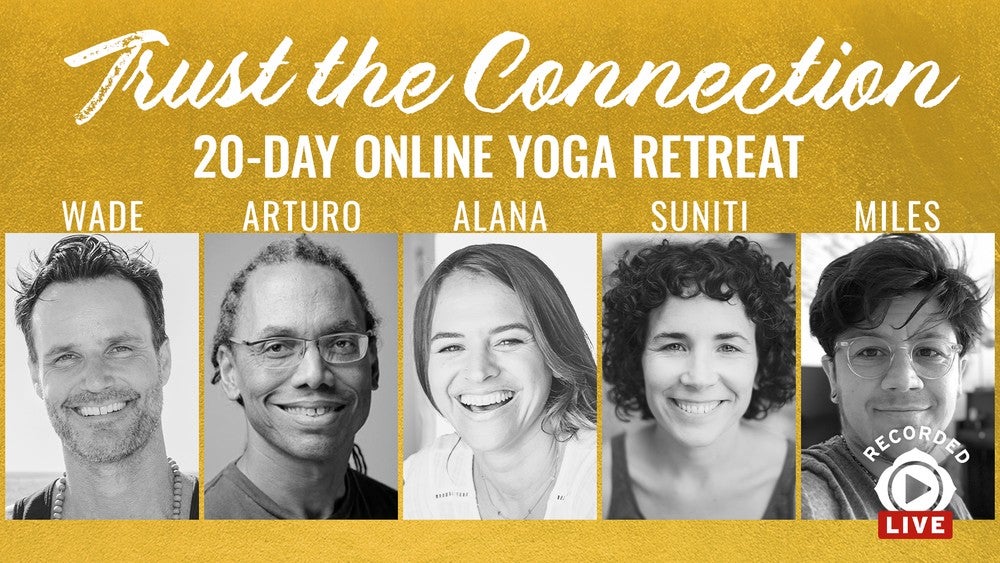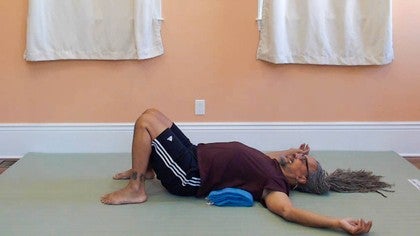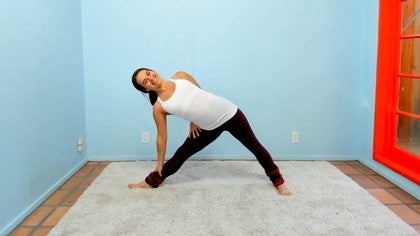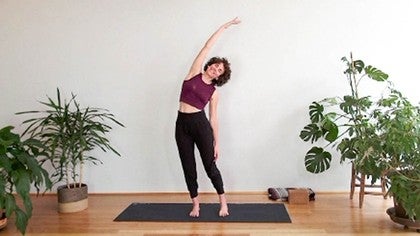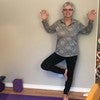Description
About This Video
Transcript
Read Full Transcript
Hi, folks. Welcome. I'm Arturo, and thanks so much for joining us on day two of Trust the Connection, our 20-day yoga retreat. I'm in New Orleans, Louisiana, down in the south coast of the United States, facing the Gulf of Mexico. And we're going to need some props for today. So if you have a blanket or two blankets or two towels, you'll want a blanket to put over you for the final relaxation for Shavasana. And then one towel or blanket, because we're going to do a restorative pose kind of towards the end of practice. Since you've already gathered your props or are gathering your props, you can come up to standing. And if standing is uncomfortable for you, or if anything is uncomfortable for you, remember you're the one inside your body. So if something I'm suggesting hurts or sucks, you don't have to do it. Do it a little smaller. Do it a little gentler. Yoga, I believe that yoga should feel really good during the practice and after the practice too. So take care of yourself and really check in with your breathing as you're practicing. So we're going to start in a standing position or seated position, whatever is comfortable. And today we're going to focus on opening the heart space. And usually when we focus on the heart, we focus on the front of the heart, but that kind of ignores the whole back of the heart that's happening here. So I want to tune into the shoulder blades and tune into the space at the back of the heart to get that to open. So first off, let's find our shoulder blades. They're tricky because we can't see them. We don't have eyeballs back there, but if you take one hand, I'm taking my right hand and reaching under my armpit and feeling around for the scapula. If I press in and circle around, I can feel the scapula and I just want to feel it. Use a little finger pressure on it and then a little movement to bring my awareness back to my backside, the back of my heart. I want to take the shoulder a little forward, take the shoulder blade a little back. I can even tip away from it. Just kind of feel into it just a few moments of that and then drop that hand and still keep your awareness on the backside over there. And then let's do the other side, reaching my left hand under the armpit and circling around. There's the bottom corner of the shoulder blade. I want to kind of get in the middle of it and bring my awareness. Since I don't have eyeballs back there, I'm going to bring my internal eyeballs, my internal awareness to the back of the heart, to the shoulder blades and the space in between the shoulder blades. So to shrug them up and take them down. So hopefully now you have a little more awareness towards your backside. And sometimes it can be really helpful to close the eyes because the eyes are so focused forward and we give so much sensory, the eyes are like sensory bullies. They really take up a lot of our attention. But we have all of this richness of sensation that we can tune into, especially if we close the eyes. Okay. And then let's tune into the heart and pericardium meridians. The heart and pericardium meridians start really deeply in the center of the chest in and around the heart organ. But they come out to the surface in the area of the armpit. And as the meridians go down the inner arm and the palm side of the hand, the energy of the meridians becomes more superficial, more closer to the surface. So it goes from deep to superficial. And we're going to spend some time focusing on the superficial part. As an acupuncturist, these superficial parts are easiest to access. It's a little harder to get really deep in and we don't want to needle the heart actually. But it's harder to get into the sum of the deeper points. So let's take one forearm. I've got my right forearm forward and I'm going to just relax it. And with my left hand, I'm going to smoosh the palm side of the forearm. So the heart meridian is on the pinky side and then the pericardium is right up the middle. And we want to kind of treat, smoosh both of those and come all the way down to the wrist and then into the center of the palm and smoosh around in there. It might be a little achy, especially if you've been spending any time on gaming machines or on a computer. Smoosh around in there. And one nice thing you can do if you find a tender point in the center of the palm is to let the fingers relax, press the tender point. Oh, that's a good one. And then slowly stretch the palm open and then relax. Find a little tender point, smoosh it and stretch the palm open. Good. And then take ahold of the fingertips and stretch. Let's turn the palm forward like you're saying, up and take the fingertips back towards your shoulder. And again, we're going for feeling along that palm side. I can even start to reach my arm across my body to get that whole plane of the heart and pericardium meridians. Oh yeah, and breathe. So you can experiment here. Again, you're the one inside there. Find what feels deliciously yummy for you. You may even want to take the palm and turn it palm up and take the fingertips back towards the elbow. Oh, that's rather nice. And play again with the movement. At the same time that I'm moving the arm, I'm bringing my awareness back to my shoulder blade and getting my shoulder blade to wrap around towards the front of the body. And then slowly release. Let your arms rest at your side. You might have a little different awareness in that side that you are just smooshing and stretching. Let's go over to the other side. So again, on this side, I'm going to my left side. Starting in the area of the armpit can be kind of tender and then going down the palm side. But we're really going to smoosh from the elbow down the middle and towards the pinky side of the hand. And you notice as you smoosh it, your fingers will kind of move on automatic. When I have something in the way, my wrist watch so I can just set that off to the side because I don't want to skip these points down by the wrist and come into the center of the palm. There's actually a little mini chakra. It's like a satellite chakra that connects to the heart chakra that's in the center of the palm. And just like the other side, you might find a tender point. You can press into it and then slowly stretch the fingers open while you hold that pressure and then relax.
Press into it. Find a little tender spot. Right there. And slowly stretch the fingers open. Right there, right there, right there. Stretch the fingers open. And then relaxing. And we'll take a stretch into this side. Let's do the same thing starting in the stop position and draw the fingertips back towards the shoulder. And then play with the movement of the arm and shoulder blade. Getting my shoulder blade, bringing my awareness back to the shoulder blade at the same time that I'm stretching through the palm and forearm. Oh and breathing. Surprisingly intense on this side for me. So one guideline that you can use in terms of overdoing it or underdoing it, notice your breath. If you're breathing like this, back off a little bit. I don't remember the exact wording of the yoga sutra, but it does say that the breathing should be free and easy. And then you can try turning the palm like you're going to receive a low five. Lengthen out and take the fingertips back towards your hip. And again, moving the shoulder. Reaching across the body. Maybe reaching up a little high. Oh I'm getting a whole stretch into the, I'm getting into the armpit part of the heart and pericardium meridian through this movement. Because of the fascia, the connective tissue, everything is absolutely connected to everything. So when I make the connective tissue a little taut, take the slack out of it and then take some movement. I can feel this stretch into the heart one area of the armpit. I can also feel this stretch all the way down into my sacrum near my tailbone. Getting my shoulder blades to move. And then coming back to center and releasing the hands. Shake out the arms for a moment. Bring the awareness back to the backside of the body between the shoulder blades and including the shoulder blades. And draw the shoulder blades up towards the ears and back down again. This time we're going to bring them up and we're going to hold them up. Just gently shrugging them up. Don't press them actually into your ears. Just holding them up for a few breaths. About 10 to 15 seconds. In your next exhale, relax and reach the fingertips a little bit like you're trying to touch the floor to stretch the sides of your neck and the tops of your shoulders. And then relax. Gently, slightly, shrug them up again. Getting the muscles that elevate the shoulders to contract on purpose. Most of us spend a lot of the day with them contracted accidentally. But we're getting them to contract on purpose. And then getting them to relax on purpose and reach the fingertips towards the floor.
Lengthen the top of the head towards the sky. And then relax. And let's come on down to seated. And I'm going to take the blanket that I got. Some of you may not need this. I know I need it. Because when I come to seated, I am tight enough in my hamstrings and hips that if I come to seated without anything underneath me, I'm kind of rounded. So when you're sitting up in a cross-legged-ish position, you want to feel your hips are level with your knees or a little higher than your knees. If your knees are higher than your hips, it's a lot of pressure on your low back. And so if that's the case, just raise your throne a little bit higher. That'll bring you closer to that heavenly energy anyhow. We're going to do a little bit more on the shoulder and neck, this time just one shoulder. I'm going to shrug my right shoulder up a little towards my ear, just a little bit. I'm going to turn away from it and then look up a little bit. And I'm going to hold it here about 10 seconds while breathing. Five, six, seven, eight, nine, ten. Then I'm going to relax my shoulder. I'm going to keep my head turned about 30 degrees to the opposite side and then look down towards my knee or towards my hip and release my fingertips down.
My hand and arm, my right hand and arm is heavy. And then come back up to neutral. I'm going to just keep facing that angle, gently shrugging that right shoulder up, gently looking up, tipping the chin up slightly and holding for about 10 seconds. Three, four, five, six, seven, eight, nine. And as I exhale and relax, I'm going to look down, relax my shoulder down and release my hand towards the floor, stretching this whole line and getting into this upper part of the shoulder blade that is often held tight. And third time's the charm, slowly shrugging, bringing the eyes back to the horizon, still turned about 30 degrees away from the shoulder that I'm going to shrug up, gently look up, hold the position without holding your breath. Four, five, six, seven, eight, nine, ten. Slowly release the shoulder, slowly look down, release the hand and hang out in the stretch for a few more breaths. Now if you're left handed, this is probably the shoulder that you might hold the phone to your ear with. Slowly bring your eyes back to the horizon and then turn your gaze forward again. You know how people hold the phone? I hope everybody can let that go. That's just one of the habits. Get a headset, let that go. We can be done with that. It's great for my business as a massage therapist, but it's terrible for your neck and shoulder. So now I'm going to turn away from my other shoulder, from my left shoulder, about 30 degrees away. I'm going to shrug that left shoulder up gently and look up just a little and hold it here while breathing, holding the position but not holding my breath. Five, six, seven, eight, nine, ten. Slowly release the shoulder down as I look down towards my right hip and I can release my left hand out to the side. And then coming back up to look at the horizon, still with my head turned away from the shoulder that I'm going to gently shrug up, gently look up and hold that position. Three, four, five, six, seven, eight, nine, ten. And then relaxing the shoulder as I slowly look down, I can release my hand towards the shoulders. I don't know about y'all, but I'm getting a really delicious upper neck side of the head stretch here. I'll moan and groan for you or you can moan and groan in the privacy of your home. And bringing the eyes back up to the horizon, gently shrugging that same shoulder up and looking up slightly and holding that position. Just getting those muscles to contract slightly. Four, five, six, seven, eight, nine, ten. And releasing the shoulder down, release the hand down and look down towards your hip or your knee. And then slowly bringing your eyes back to the horizon and turning your head forward and just take a pause here and notice how your head and neck are feeling. In Western culture we tend to get really compartmentalized, like the head and neck are separate from the shoulder and the arms are separate from the torso and everything is absolutely, absolutely connected. So when we're releasing the neck, we're also releasing the shoulders, releasing into the arms, we're releasing into the low back, everything is connected. Let's do a little more gentle movement of the neck. Imagine that you're Pinocchio with a long nose and I'd like you to draw a few circles. You can put a paintbrush on the end of that nose, draw a few circles on the wall in front of you. See if you can make it round. They don't have to be huge circles, they certainly don't have to be fast circles. Going slow often helps you feel more. Notice if you've got corners in your circles. And the next time you come to the bottom center part of your circle, pause and reverse directions. You can go as small as feels good. If you have a neck injury, it might be a really tiny, tiny circle. Check in with your breath. If you're clenching your breath, go a little smaller, go a little slower. Notice if your jaw is trying to help you draw these circles or the muscles in between your eyebrows are working. Let them go. And the next time you come to the bottom center of your circle, pause and slowly bring your eyes back up to the horizon. We're going to do a little bit more seated. If your back is not liking sitting on the floor, you can do this in a chair. You would just scoot forward towards the edge of the chair. I'm going to turn sideways so you can see what my spine is doing. But you don't have to. Whoa! Sitting up tall, if you're on a chair, you're going to scoot forward towards the edge of the chair and bring your palms to your knees. We're going to do the cat-cow movement. So as you inhale, start to arch your low back. Lift and open the front of the heart. The shoulder blades are moving back towards each other slightly. As we exhale, you're going to tuck your tailbone slightly. Get sticky with the palms on the knees. Let the chin drop towards the chest. And we want to feel the shoulder blades move apart from each other, opening the back side of the heart. As we inhale, arching the low back, slowly lifting the heart to open the front side of the heart. Gazing up gently as you start to exhale, start to tuck, let the spine round, lean into the hands, open the back side of the heart. A few more times. Going at the rhythm of your breath. My breath can move pretty slowly. And if you're used to doing Ujjayi Pranayama, you can use that to slow down the breath as the breath moves, so your body moves. One more inhale, opening the front of the heart, getting tall, looking up slightly. Then exhale and rounding, we're going to hang out in the rounded position for a while. So again, bringing the awareness back to the back side of the heart. And you can move a little bit. Try moving one shoulder forward, the other shoulder forward. You can try moaning and groaning. Sound is vibration, and vibration helps move the physical and the energetic body. Coming back to the center, slowly inhaling, bringing the spine back up to neutral, bringing the heart over the hips, the head over the heart. And pause. Now, if you brought in a big throne, we're going to come off the throne. And I'm going to keep one of these for a head pillow, because I know because of the shape of my spine, I need a little more head support. If you know you have a little bit of a slouch, when you come onto your back, if your chin is tipped up, bring a little more support underneath your head. So coming onto your back, and we want to feel into, we're going to use the floor for a little massage tool. I'm going to take my palms, reaching towards the ceiling, turn them so the palms are facing out and the thumbs are facing down towards my feet. And then I'm going to cross, I'm going to do the left over the right and cross my arms, and then interlace my fingers. Complicated. So now, keeping that feeling, I'm going to reach my fingers, reach my arms towards the ceiling, and rock over to one side. What I'm trying to do is to feel the floor massage that space between the shoulder blades. If you're not feeling much, you can try lifting the hips slightly. Now for that, I'm going to take the head pillow out, lift the hips slightly, and do the same thing. It doesn't have to be a big move. And again, if your arms hurt, you have a shoulder injury or something, you can bring the arms and just cross them across the chest. Reaching the arms across the body helps the shoulder blades move away from the center of the spine to get more space to massage into that part of back. Come back to the center and lower the hips down. Take a pause. I always feel like, what's the name of the bear? Baloo, the bear from Jungle Book, the way he's always rubbing up against trees. I do that around my house. I do that with doorknobs. I'll massage into my back with doorknobs and such. So other side, I'm just going to switch which arm is on top, interlace the fingers, or I can just cross the arms over. I'm going to lift the hips if I need to. If I'm feeling plenty with the hips down, or if it hurts to lift the hips, oh, I don't have to lift the hips. There's plenty of sensation to be gotten. And that sensation brings awareness to the backside of the body. Awareness is so key. If we feel what we've been doing, if we know what we're doing, we can choose to shift patterns that might be causing pain. Then come back to the center. Let the arms cross across the chest and just take a pause here for a few breaths. And then unwind the arms. Bring the arms down along your sides, palms down, fingers facing the same direction as your toes. If you have a blanket under your head, go ahead and slide that out. We're going to come into a gentle bridge. So from here, I want the feet to be close enough in that I can touch at least my heels. So bringing the heels in close to the hips. I'm going to inhale. As I exhale, I'm going to engage my six pack and then press down with my feet and lift the hips. It might be that I lift my hips two inches. It might be that I lift my hips all the way to the ceiling. Whatever feels good, you can keep the hands along the sides. Some of you may want to slide the hands in underneath the back and interlace the fingers or bring the palms together. For some of you, that might not be the ticket. Find what feels best for you. And we're going to hang out here another breath. Next, exhale, slowly lowering the hips. Wag your tail a little bit to just rock your body. Going to do that two more times. Palms down along your sides. Inhale. As you exhale, engage the abs. Press down, lift the hips. Palms can stay here. Or if you're feeling particularly sparky, you can interlace the fingers, pressing the palms together. And breathe. Keep your gaze straight up towards the ceiling. When you lift your hips and there's more weight on your upper shoulders and your neck, keep your nose pointing towards the ceiling. Keep your eyes pointing towards the ceiling. On your next exhale, slowly lower down all the way.
Hold your tail. Third time's the charm. Inhale, palms down. Exhale, abs engage. Lift the hips. Pressing or interlacing the fingers or pressing the palms towards each other. Whatever feels best for you. Try to get some space in the front of the hip. This is a nice counter pose for all the sitting that we do in chairs. Sitting with the hips bent at 90 degrees. Not exactly what the human body is designed for. If you have your hands underneath, take them out. And if it feels comfortable, reach the palms towards the ceiling. Fingers towards the ceiling, that is. And inhale. Keep reaching as you lower slowly down the back. Until the low back lands. And then draw one knee at a time, not towards your chest, but out towards your armpits. Take a hold of either the back of the knees or the outsides of the feet. Come into happy baby pose. And rock a little side to side. Come back to center. Slowly release the feet down. Release the arms down. Take a pause for a breath. And then rolling your way onto one side. Whichever side feels more comfortable. You can lay your head on top of your arm or slide your blanket or towel underneath your head. Take a pause in this pose. Oh yes, this is a yoga asana. It's a very advanced asana. And from here, let your head stay heavy. Your neck relax. Roll your top shoulder a little forward. Your nose starts to point towards the ground. And press your hands to slowly roll up one vertebrae at a time. Coming up to seated. We're going to lie back down in just a moment. But we have to get a prop in position. So if you have a towel or a blanket, there's going to be a few options. The height is going to really matter. So this is the lowest height. It's about yay big. Inch and a half. I don't know what that is. Metrically. Sorry. About that thick. So that's going to be the lowest height. I could fold this in half. Or I could fold it in thirds. Now deeper isn't necessarily better. This is really intense and we're going to stay here for about six minutes. So that's very intense. For me personally, I'm going to go to about that height. But don't be shy about going lower. Lower is fine too. What we're going to do is lay back over this. And this top edge is going to come to the bottom edge of the shoulder blades. So we have to feel that. The bottom edge of the shoulder blades would be right about where a bra strap comes. Just below this bottom corner of the shoulder blades. I don't want this blanket to be behind the shoulders. I want it to be just below the shoulders. So I'm going to sit facing away from the blanket. And I want to kind of eyeball it. This is going to be too high. I want to eyeball it. I'm going to use my abs and my hands. And slowly come back. Now I can feel that it's too low. I can already feel here's the bottom corner of my shoulder blade and it's too far that way. So to change it, it's pretty easy. I could just lift my hips and slide it up. If it's too high, let me show you what that looks like. If it's too high when I lie back, then my head is tilting way, way back. And I'm not getting any help opening the front part of the heart. And it's a little harder to adjust it. I can just slide forward until I feel that top edge of the blanket or towel right at the bottom corner of my shoulder blade. And I want to check out how that height is. I'm going to keep my knees bent, especially because my low back is an area of focus for me. So it feels better for me to keep my knees bent. And I'm going to walk my feet a little wide and let my knees rest into each other.
Now I can tell that this is going to be too tall for me even right now. I'm going to readjust. If you're feeling good, you can stay there. But I'm going to go to the next one lower. That means I'll have to probably sit on this. And scoot to find that. Okay. This is a little gentle for me. But the good thing is we're going to stay here for a long time. We're going to stay here for about six minutes. So the advantage of going a little gentler is that it's easier to stay longer. And as we stay in this position with this very, very gentle heart opening support, our fascia, our connective tissue is going to gradually melt open. So if I were to do this every day for a few days, I would probably within a week be able to fold it in half and be comfortable staying there as my body shifts. The connective tissue remains changeable. It remains plasticky and changeable. And it really responds well to low intensity stretches that we hold for a long time. As we settle in here, let's take a few breaths into the upper chest, intentionally expanding the ribs with the breath. And notice that edge of the blanket as you inhale into the chest. Notice how it presses in to the blanket and helps give more awareness to that back side of the heart. The chest breath. Still for this, you may also feel that the side ribs are expanding. And then the next few breaths, take it down to a belly breath. So as you inhale, your diaphragm is going to drop down and that's going to make your belly expand. And as you exhale, the diaphragm relaxes and the belly comes back in. Inhale, the diaphragm drops down, draws down, expanding the belly, stretching the heart long with the inhale. As you exhale, the diaphragm relaxes, the lungs draw the diaphragm up and the belly comes back in. A few more belly breath also helps us turn off the fight or flight response and helps stimulate the rest and digest response. You're also massaging your digestive organs with each belly breath. And as the diaphragm draws down and the inhale, it's stretching the pericardium, the connective tissue covering the heart, lengthening the heart as the diaphragm draws down. So you're getting your heart to do some yoga. You may notice your digestion speaking to you, some gurgles and verbals. That's a good sign. The next three breaths. Still the belly breath on the inhale and as you exhale, let a little sound out, a little ah. Inhaling. Third one.
And then letting go of the effort with your breath. Letting your eyes close if that's comfortable. Letting your heart just melt open and your breath moves at its own natural rhythm flowing in and out across your body. Exhaling. And as you're ready, take a few chest breaths again, and notice if the blanket behind your heart is giving you some different information after you've melted onto it for so long. And then a few belly breaths. Inhaling buddha belly. And if you've been sitting with your knees resting into each other, go ahead and separate the knees slightly. If you happen to straighten your legs out, you can bend your knees and plant them on the mat. I'm gonna press down with my feet, lift my hips just enough that I can slide the support from beneath my heart, and then lower the hips back down. I'm gonna take that blanket or towel that was behind my heart and make it into a head pillow. Ooh, and we're gonna get ready for the final relaxation. So if you have a blanket to put over you, bring that close by. You may even want to open it up and get it ready. But don't cover yourself just yet. So if you want a head pillow, make it just right. Not too tall, not too low. Take your arms out to the sides and draw one knee at a time up towards your chest. Inhale. As you exhale, take both knees over to one side and take your nose the opposite direction of the knees. So you might want to slide, if it's uncomfortable, you might want to take that extra blanket and slide it under the knee that you're tipping towards for a little support. Take a few breaths in the twist. Go for the belly breath here, and you'll feel how the twist is changing the shape and movement of your breath. Next, inhale. Draw your knees and your nose back to center. If you like that support under the side, then bring that support to the other side. Arms out to the sides, knees up towards the chest. Inhale. Exhale to the other side of the twist. Feet can come down to the mat if you want. Nose goes the opposite direction of your knees. And take a few deep belly breaths here. I notice again how this twist is reshaping your breath, helping your breath move into corners that may not have been moving. Then your next inhale, drawing the knees and nose back to the center. Take your blanket and cover yourself. We're setting up for Shavasana. You may want to keep your knees bent, letting the inner knees rest into each other, or you may want to straighten your legs out. It's up to you, whatever feels better. As we settle into Shavasana, we'll be here for about just a couple of minutes, but if you want to stay in Shavasana at the end, as I talk people up into sitting, you can just stay and rest in Shavasana. There will be a little music that comes on as we end the class. Take a few deep belly breaths here. With each exhale, surrender a little more into the support of the floor. Relaxing your jaw, relaxing your hands and your feet. You're welcome to stay here in Shavasana.
If you're coming out of the pose, you can bend the knees up and slowly roll onto one side. Pause on your side for a breath or two. From your side, let your head stay heavy. Roll a little forward and slowly come up. If you're staying in Shavasana, stay in Shavasana. Namaste. Thank you so much for coming.
Trust the Connection: 20-Day Yoga Retreat
Comments
You need to be a subscriber to post a comment.
Please Log In or Create an Account to start your free trial.

